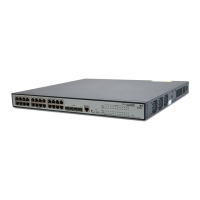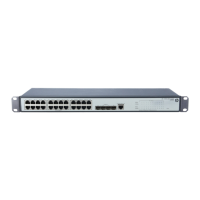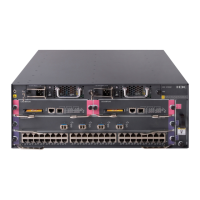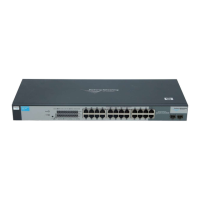135
Introduction to port-based VLAN
Port-based VLANs group VLAN members by port. A port forwards traffic for a VLAN only after it is
assigned to the VLAN.
Port link type
You can configure the link type of a port as access, trunk, or hybrid. The link types use the following
VLAN tag handling methods:
An access port belongs to only one VLAN and sends traffic untagged. It is usually connects to a user
device unable to recognize VLAN tagged-packets or when there is no need to separate different
VLAN members.
A trunk port can carry multiple VLANs to receive and send traffic for them. Except traffic from the
port VLAN ID (PVID), traffic sent through a trunk port will be VLAN tagged. Usually, ports
connecting network devices are configured as trunk ports.
Like a trunk port, a hybrid port can carry multiple VLANs to receive and send traffic for them. Unlike
a trunk port, a hybrid port allows traffic of all VLANs to pass through VLAN untagged. Usually,
hybrid ports are configured to connect devices whose support for VLAN tagged-packets you are
uncertain about.
PVID
By default, VLAN 1 is the PVID for all ports. You can change the PVID for a port as required.
Use the following guidelines when configuring the PVID on a port:
An access port can join only one VLAN. The VLAN to which the access port belongs is the PVID of
the port. The PVID of the access port changes along with the VLAN to which the port belongs.
A trunk or hybrid port can join multiple VLANs, and you can configure a PVID for the port.
The following table shows how ports of different link types handle frames:
Port type Actions (in the inbound direction) Actions (in the outbound direction)
Untagged frame Tagged frame
Access
Tags the frame with
the PVID tag.
Receives the frame if its
VLAN ID is the same as
the PVID.
Drops the frame if its
VLAN ID is different
from the PVID.
Removes the VLAN tag and sends the
frame.
Trunk
Checks whether the
PVID is carried on the
port:
If yes, tags the
frame with the
PVID tag.
If not, drops the
frame.
Receives the frame if its
VLAN is carried on the
port.
Drops the frame if its
VLAN is not carried on
the port.
Removes the tag and sends the frame
if the frame carries the PVID tag and
the port belongs to the PVID.
Sends the frame without removing
the tag if its VLAN is carried on the
port but is different from the PVID.
Hybrid
Sends the frame if its VLAN is carried on
the port. The frame is sent with the VLAN
tag removed or intact depending on
your configuration.
